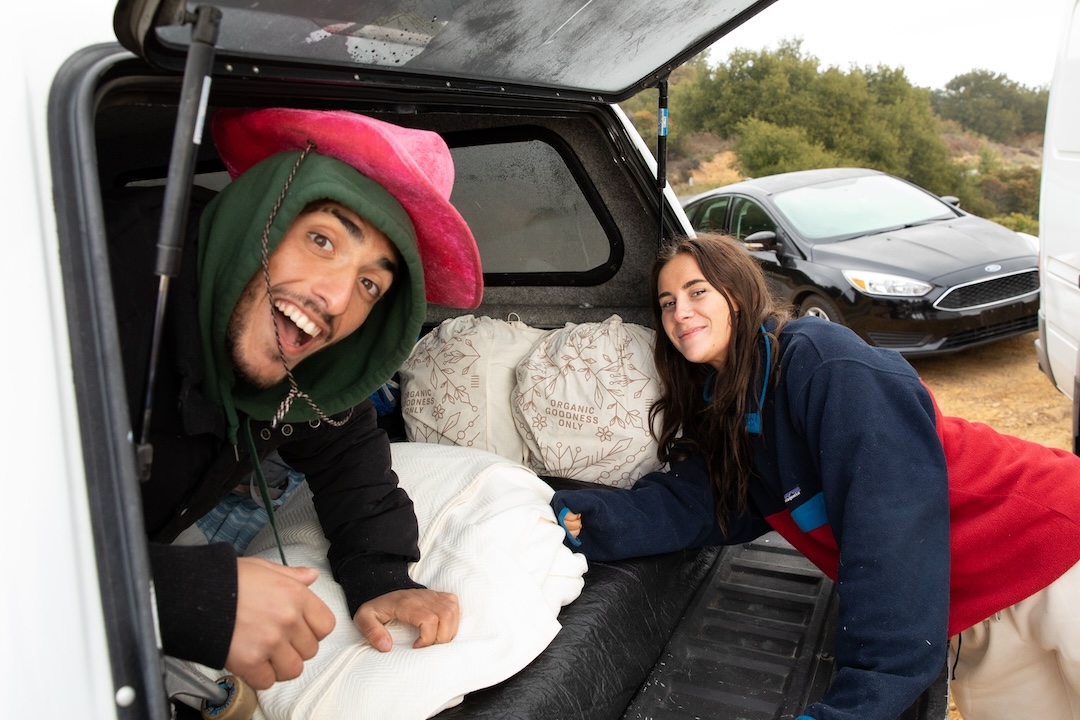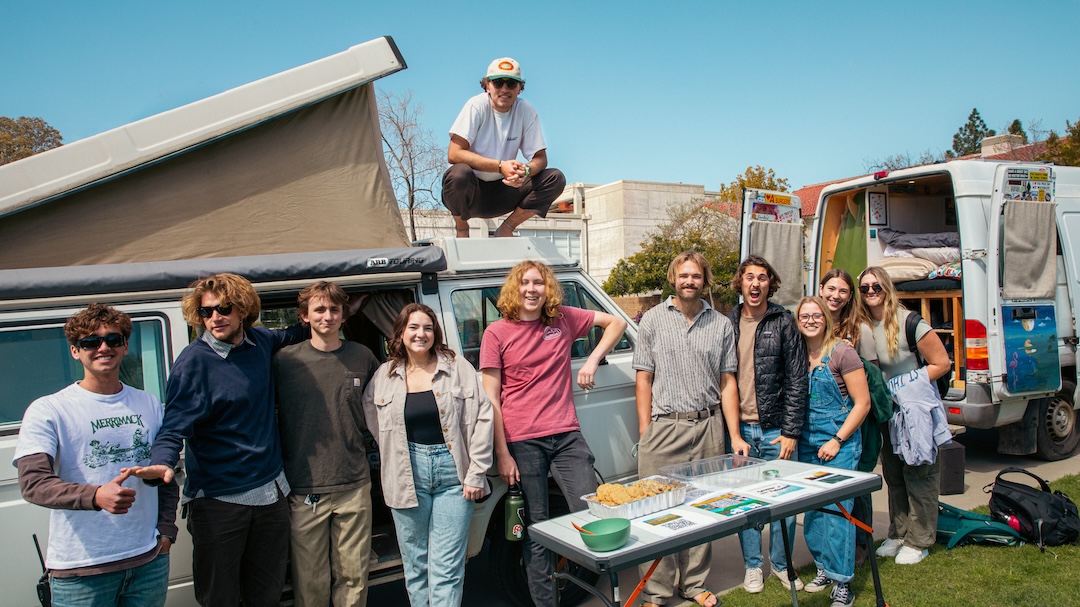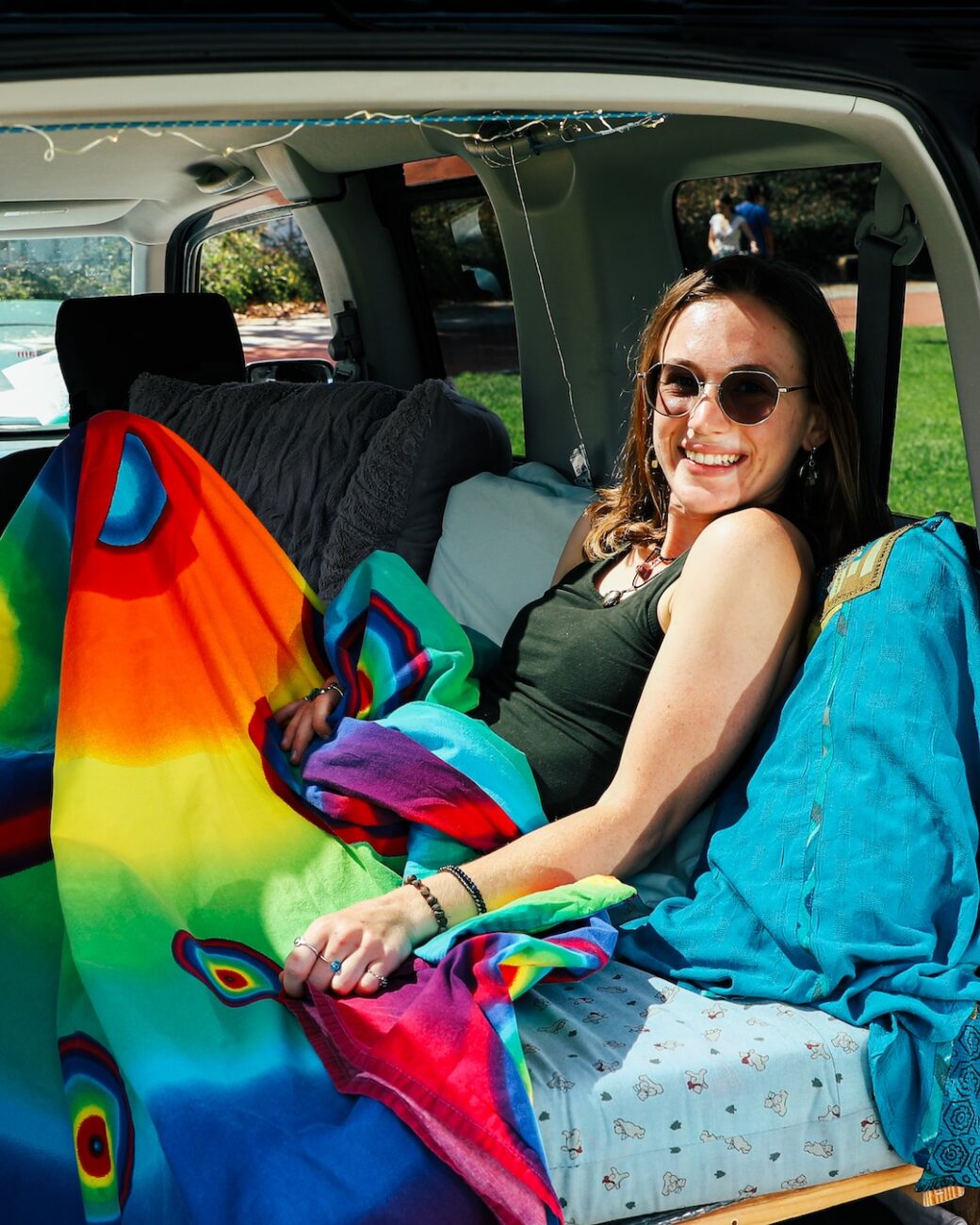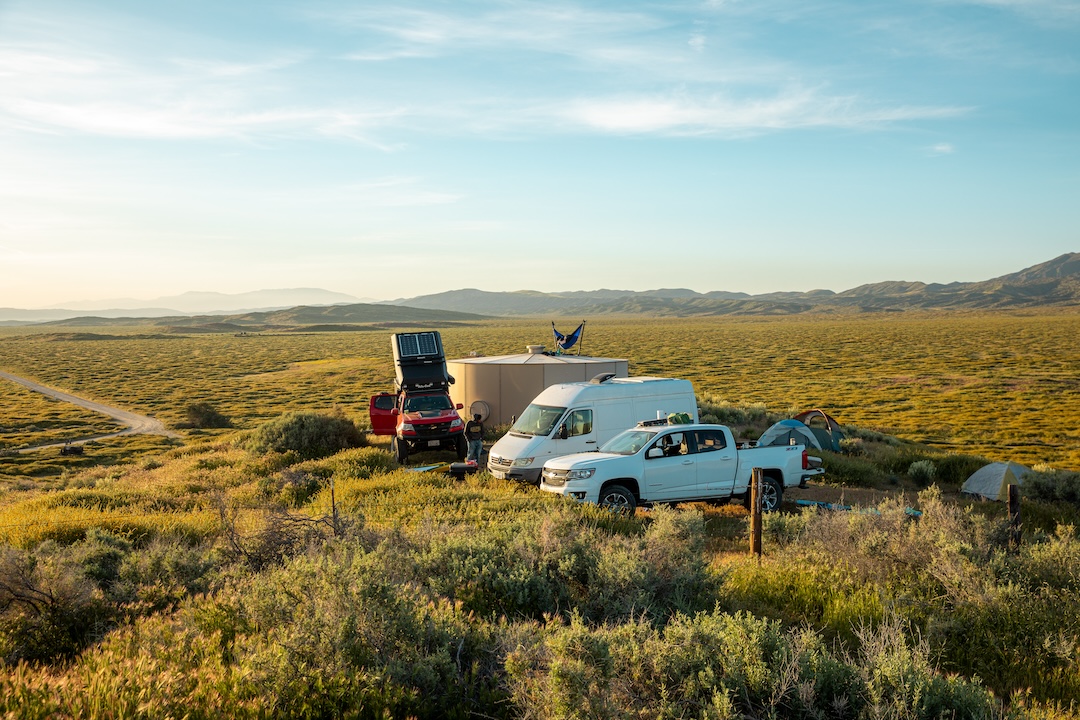Adopting an easygoing attitude and expansive curiosity of outdoor exploration is all that is required on any Cal Poly Van Life Club trip, for the ever-growing community of members includes a range of students — some who own built-out vans and some who have yet to buy a car, some who have road tripped across the country and others who have never left the state.
This inclusion has bloomed over the years into a beautiful camaraderie of like-minded students of all grades and majors who derive joy in the simplicities of life and travel.
Recent Van Life events have included camping at Point Reyes, watching the sunset near the Cayucos shipwreck and exploring Rinconada Mines near Santa Margarita Lake. Collaboration events with other clubs, like Grover Takeover with both Thrift Cal Poly and Mustang Surf Club, as well as a hike to Valencia Peak and overnight camp on Cuesta Ridge with UCSB’s Excursion Club, has also given members chances to get outside with new friends and in touch with nature.

“It’s just about sharing that interest and wanting to be around people who have rigs to maybe learn from,” mechanical engineering senior and Van Life club co-founder Nikolas Tanski said, touching on how the club has acted as a starting point for connections to be made, ever since its genesis in 2022.
The fascination with van living is shared and embraced by many club members, who look not only to their future travel plans but also to the current student body who make up the club and have more experience.
The founding of Cal Poly Van Life
The white, unassuming exterior of Tanski’s sprinter van draws little attention when parked on the street. But as the back doors, lined with stickers and painted with scenes of sunsets and oceans, are opened up, it becomes obvious that the vehicle isn’t just that — it’s also a home.
Inside the van, a surf rack holds the various boards Tanski has collected from years of surfing. Tibetan prayer flags are strung along the wood-paneled ceiling and homemade crates of his modest collection of belongings are stored under the bed that he came home to each night for two years as a student at Cal Poly.
Pursuing van life was always something that appealed to Tanski. But like true-life projects, the process took time.

Surrounded by the surf van scene of Dana Point in Orange County, Tanski grew up fascinated by the sight of people’s built-out rigs and came to understand the value of having one’s home on wheels. With a love for camping, surfing and exploring, Tanski mulled over how simple it would be to pursue his passions with all belongings readily available in the same place.
When the term “van life” really took to social media, it was in middle school that Tanski started absorbing the videos of van tours or how-to tutorials posted all over YouTube.
“I just became so stoked,” he said.
But this dream didn’t turn to reality until Tanski, two weeks into freshman year at Cal Poly, met a student — with his own built-out Volkswagen bus in Morro Bay — who showed him that living in a van during college was not an impossible feat.
“For me, it just made so much sense,” Tanski said. “But I never even thought it would be possible until I met him.”
During the remainder of Tanski’s freshman year, he took time creating budgeting plans and sketching up ideas, while continuously ordering parts for the build, including a fridge, insulation and different pumps. After scouring Craigslist to find a van, Tanksi was soon traveling down south to pick up a 2005 Dodge Sprinter Van that, as he described, was just a lady’s old beach rig.
This “empty shell” of a car gave Tanski a blank canvas to begin building and personalizing.
As an engineering student, Tanski recognized that internships were going to be difficult to secure as a freshman, so he took the summer of 2021 to do his own. Building out a van to live in wasn’t just a life and financial play, as Tanski said. It was also an academic one, getting to experiment with carpentry, electrical and design work and ultimately produce a project portfolio to showcase later on.
When Tanski first started his build, he was overrun by excitement.
“I knew the task I had ahead of me, but I just knew it was going to be the dream come true,” he said.
Putting in over 60 hours of van work each week for 10 weeks, Tanski breezed through framing and subflooring, and with the guidance of YouTube videos and his family friend with a full woodshop, worked out the electrical systems.
Tanski experienced moments of worried confusion and questions of timing throughout the process, but as soon as the parts started coming together and Tanski could begin using his van, his motivation to finish the project was ever-growing.
However, there was no time to celebrate when the van was complete, as Tanski was awake tending to the finishing touches the night before he was set to leave for San Luis Obispo as a Week of Welcome (WOW) leader. As Tanski reflected, he jumped into van living very quickly, soon realizing that there was still a lot to learn.
“It wasn’t just like ‘Oh, I have this cool adventure rig,’” Tanski said. “It was a total life pivot.”
The first month was without running water, and the first year was without a heater. Navigating where to sleep and not having a permanent fixed spot was also a dynamic that Tanski had to learn. However, taking it a day at a time, he resolved many of those issues and soon found his flow.
Having always enjoyed feeling simplistic and finding value in curating a small but personal collection of things, moving into a van with little space was manageable for Tanski.
Experience has always been one of the biggest motivators for Tanski living in a van, for as a high-energy person, exploring and staying active fuels his life. Van life calls for zero need to pack or plan and requires less motivation and time, making trips more accessible.
“Having a rig that’s loaded up with my skateboards, my surfboards, my snorkel stuff, climbing gear and my volleyball and tennis rackets, I have everything at all times, and I just go,” Tanski said.
Beginning sophomore year of school living in his van, Tanski knew he needed to continue meeting more people like him.
There was this feeling, “I’m not doing van life — I’m just doing my life but sleeping in a van,” Tanski said. “I kind of decided I’m going to choose a life that is maybe more isolated, living alone in a car, so I really wanted to dive into the campus community.”
With this motivation to get involved in any way possible, Tanski rushed the ZBT fraternity and soon had a core group of brothers he could always go to, as well as a main house.
“Having a place I felt comfortable parking and walking inside was important,” he said.
Tanski discovered Van Life Club in its earliest stages and quickly connected with the founder, Jake Grove. He found the atmosphere to be an amazing space to befriend more students passionate about the outdoors, so when Grove graduated in 2022 — leaving what Tanski described as his “passion project” behind — he took over as president and worked to grow a welcoming community for anyone interested.
Spending his whole upbringing in Boy Scouts, Tanski initially tried to implement a lot of structure within the club. At one point, Van Life participated in facility tours with local van conversion companies and talked about getting members into shops to do builds together and participate in more advocacy work for alternative living.
But, upon reflection, Tanski has come to recognize the beauty in embracing the low-maintenance and free-flowing nature the club has come to embody.
The students of Van Life

As a sophomore, computer science senior Ethan Jerram went to a Van Life club campout in Montana de Oro State Park and soon returned with new friends, carpool connections and stronger passions for exploring the areas in and around San Luis Obispo.
Growing up in the Bay Area, Jerram frequently camped with family in the Santa Cruz mountains and explored Big Basin and Butano State Park. But it was after joining the club that Jerram really embraced his passion for the outdoors.
Two years later, reflecting on the inviting nature of Van Life, Jerram appreciates the club’s openness to newcomers, having been that shy, younger student who didn’t have camping gear or a car of his own.
“We use the term ‘van life’ very loosely and it makes the club more accessible,” Jerram said. “Plenty of people are only interested in car camping at campsites, and others go to the events just for day hiking and hanging out.”
To the core, what Van Life focuses on is creating a space where friends get out and in touch with nature. There’s a lot to be gained by going with the flow, for as Jerram said, “in the end, any day outdoors is a good day.”

Having spent the last summer doing a computer science internship, Jerram felt burned out and was drawn to take a quarter off and spend months on the road before graduating and transitioning to work full-time.
He bought a Toyota 4Runner and a rooftop tent with no plan other than to eventually get to Banff, Canada. Jerram traveled through Oregon, Washington and British Columbia before making it to Alberta. Slowly making his way home, Jerram explored Montana, Wyoming, Colorado, Utah and Mexico.
Reflecting on his big loop of the Western U.S., Jerram found great value in doing it solo.
“I think you can enjoy it a lot more in a way,” he said, for living on your own time, you can suddenly change route and let your curiosities guide the trip in ways that group travel may not as easily allow.
With his 4Runner’s off-roading capabilities, Jerram got to remote places and slept for free on Bureau of Land Management (BLM) land, using an app called iOverlander, which offers a forum for people to share locations of camping sites.
“Life can feel like a lot and van life really gets you out there,” Jerram said.
Along with stopping at national parks, he found himself drawn to more desolate areas deep in the mountains, going where fewer people were and seeing things not as many get to see.
In similar ways, recreation, parks and tourism administration senior and Van Life media director Kenneth Bevans joined the club early into its creation, with an interest in one day pursuing van life even though he didn’t yet have a car.
Quickly, he found the community to be the perfect arena to learn from others. After taking up photography, he soon became Van Life’s media director, capturing through his lens the moments of spontaneity that each club adventure fosters.
“It’s all about the connections,” Bevans said, referencing the “spiderweb network” that is at the foundation of Van Life, allowing members to reach out to mutual friends and possibly get hosted on their travels. “Every person in Van Life club, I would say, knows an average of five other people in nearby states who would want to host anyone from the club.”

The association with Van Life opens up a world of connections to people with similar passion for adventure. As Bevans said, he can see the club getting to the point where their Slack has a “trip host” channel.
“It’s a place for people to tap into whenever and wherever they want,” Bevans said.
For psychology senior Hadas Tankel, it was after Tanski — one of her first friends in the freshman dorms — told her about the club that she decided to join.
Like many, Tankel didn’t have a car when she joined. But as many club members have reiterated, “The function of having the rigs and vans is so that we can help people get to experience these adventures with us.”
Outside of the club, Tankel has done multiple interstate road trips, her favorites being an expedition up the Pacific Northwest with her friends and a summer exploration of Lassen Volcanic National Park. She has also traveled internationally to Peru, Israel, the Dominican Republic and the U.K., and will soon live in Italy for three months.
“Taking the initiative to step outside your routine to see what your brain, body and you, as a person, can experience in life is a really beautiful thing,” Tankel said. “I think that if we stay within expectations of how we should live our lives, or how travel should or shouldn’t be, we’re missing out on a breadth of beautiful experiences.”
For Tankel that means one shouldn’t be afraid to go out and do things solo.
“I think stepping outside of your comfort zone is one of the best things you can do for yourself,” she said. “That’s the philosophy I take with me on my travels with people or by myself.”

The future of Van Life
After getting a car in the summer of 2023 and talking with Tanski and Jerram, Bevan’s travel radius has expanded.
“I could reasonably go on a road trip from here to Banff National Park in Canada and back, which I don’t think I ever thought was a possibility before Van Life Club,” Bevans said.
Jerram has hopes of securing a remote job post-graduation and plans to follow his fascination of living on the road full-time.
After two years of living in the van full-time as a student or intern, Tanski recently decided to switch things up. At the beginning of this year, he moved into a house, which he said was a “nice capstone opportunity” to spend the final weeks of senior year living with 11 other guys and his first roommate.
Come graduation, Tanski has three months to take trips before starting a job in town. While part of him wants to explore southeast Asia, he is also being called to a 30-day hike in Spain called Camino de Santiago where travelers carry pilgrim passports and stay at albergues dotted along the trail. Another part of him wants simple, unplanned time on the road in the van to see what’s out there.
While Van Life members will eventually move on to new chapters of their lives come graduation, the club and relationships, experiences and memories it fostered through the years will remain at the root of their adventurous passions.


